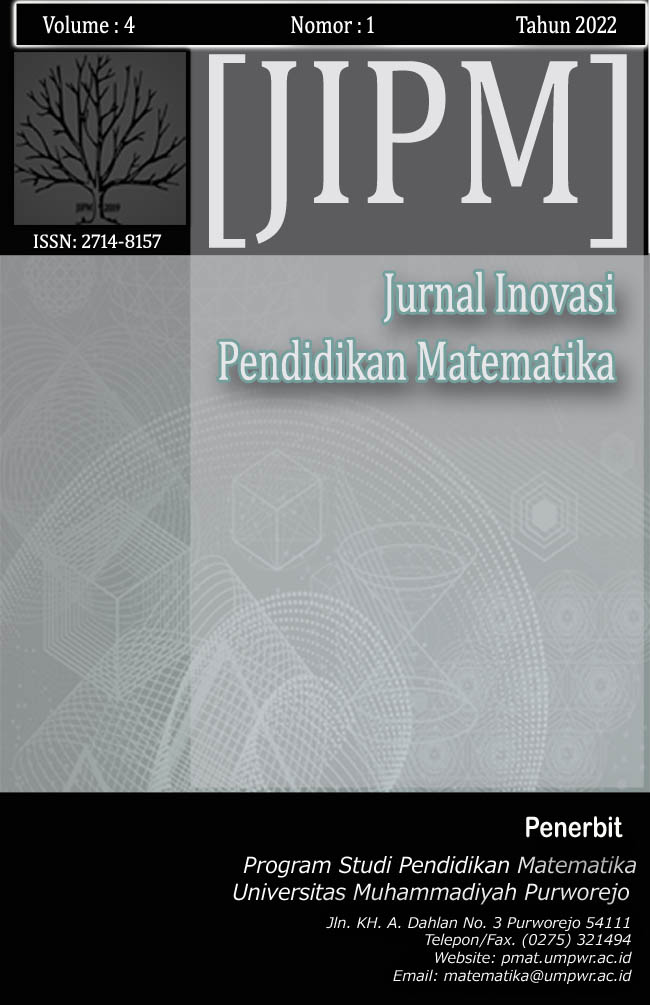Perbandingan Kecemasan Matematika pada Siswa Sekolah Indonesia Kuala Lumpur Berdasarkan Usia dalam Asesmen Formatif
Abstract
This study is descriptive-comparative quantitative research that aims to compare mathematics anxiety between early and late adolescent students and analyze the relationship between mathematics anxiety and student age. The study involved 18 students, and the data was collected using a math anxiety questionnaire adapted from Mahmood & Khatoon. Data analysis was carried out using the Kolmogorov-Smirnov test to test normality and variance homogeneity, and the t-test to compare the mean mathematical anxiety between the two age groups. In addition, the Pearson correlation test was used to assess the relationship between math anxiety and age. The t-test results showed a p-value of 0.078, greater than 0.05, which means there was no significant difference in math anxiety between early and late adolescent students. However, Pearson's correlation test yielded a coefficient of -0.522 with a p-value of 0.026, suggesting a significant negative moderate relationship between math anxiety and age, meaning that math anxiety tended to be higher in younger students. In conclusion, although there was no significant difference in the mean of math anxiety between the two age groups, there was a significant moderate negative relationship between math anxiety and age. These findings encourage the need for further research with larger samples and propose improvements in the learning process through the application of differentiated approaches, emotional support, and formative assessments that take into account age factor.
References
Auliya, R. N. 2016. Kecemasan Matematika dan Pemahaman Matematis. Formatif: Jurnal Ilmiah Pendidikan MIPA, 6(1), 12-22.
Beilock, S. L., & Maloney, E. A. 2015. Math anxiety: A Review of How the Anxiety of Math Impacts Students’ Performance and Brain Activity. Wiley Interdisciplinary Reviews: Cognitive Science, 6(6), 646-655.
Dowker, Ann., Sarkar, Ann., & Looi, Chung Yen. 2016. Mathematics Anxiety: What Have We Learned in 60 Years?. Frontiers in Psychology, 7(508), 1-16.
Hamimah & Andriani, Ade. 2023. Analisis Tingkat Kecemasan Siswa pada Pembelajaran Matematika Kelas X di MAS YMPI Tanjungbalai Tahun Pembelajaran 2022/2023. SSCJ: Student Scientific Creativity Journal, 1(3), 28-47.
Harahap, Siti. A. A & Rahman, Vebi. R. 2023. Kecemasan Matematika Siswa dalam Pembelajaran. GRIYA: Griya Journal of Mathematics Education and Application, 3(1), 135-140.
Kusairi, Sentot. 2012. Analisis Asesmen Formatif Fisika SMA Berbantukan Komputer. Jurnal Penelitian dan eval_uasi Pendidikan. 68-87.
Maswar. 2017. Analisis Statistik Deskriptif Nilai UAS Ekonomitrika Mahasiswa dengan Program SPSS 23 & EVIEWS 8.1. Jurnal Pendidikan Islam Indonesia, 1(2), 273-292.
Nawangsari, N. A. F. 2001. Pengaruh Self-efficacy dan Expentancy-value terhadap Kecemasan Menghadapi Pembelajaran Matematika. Jurnal Psikologi Pendidikan: Insan Media Psikologi, 3(2), 75.
Piaget, J. 1972. The Psychology of the Child. Basic Books.
Pratama, D. 2021. Karakteristik Perkembangan Remaja. Jurnal Edukasimu, 1(3).
Rachman, Fauzian. P. A. P., Goejantoro, Rito., & Hayati, Memi Nor. 2018. Penentuan Jumlah Replikasi Boostrap Menggunakan Metode Pretest Pada Independent Sampel T Test (Pendapatan Asli Daerah Kabupaten/Kota di Provinsi Kalimantan Timur dan Kalimantan Utara Tahun 2015). Jurnal EKSPOENSIAL, 9(1), 35-40.
Ramadan, Dimas. 2019. Kecemasan Siswa dalam Belajar Matematika. Universitas Negeri Medan, 1-7.
Sari, A.W, Mudjiran, & Alizamar. 2017. Tingkat Kecemasan Matematika Siswa dalam Menghadapi Ujian Sekolah Ditinjau Dari Jenis Kelamin, Jurusan, dan Daerah Asal Serta Implikasi.
Sari, Diana. 2017. Peran orang tua dalam memotivasi belajar siswa. Prosiding Seminar Nasional Program Pascasarjana Universitas PGRI Palembang.
Setiana, L., & Sudarman, W. 2021. Pengaruh Kecemasan Matematika Terhadap Prestasi Belajar Siswa Sekolah Menengah Pertama. Jurnal Pendidikan Matematika, 12(2), 85-93.
Setyani., Zuliyana, Fina., Rofitrasari., Amelia, Nila., & Ahsami, E. L. F. 2021. Analisis Sistem Pendidikan di Sekolah Indonesia Kuala Lumpur (SIKL): Perspektif Guru. Jurnal PGSD: Jurnal Ilmiah Pendidikan Guru Sekolah Dasar. 14(1), 70-79.
Wahidah, F. R., & Adam, P. 2019. Cognitive Behavior Therapy untuk Mengubah Pikiran Negatif dan Kecemasan pada Remaja. Indigenous: Jurnal Ilmiah Psikologi, 3(2), 57-69.
Yanti, Dwi & Yunita, Herma. 2020. Kecemasan Matematika dan Self Efficacy dalam Melakukan Pembuktian Matematika. Journal of Mathematics Science and Education. 2(2), 68-79.
Yasril, Abdi Iswahyudi., Fatma, Fitria., & Febrianti, Diana. 2021. Penerapan Uji Korelasi Spearman untuk Mengkaji Faktor yang Berhubungan dengan Kejadian Diabetes Melitus di Puskesmas Sicincin Kabupaten Padang Pariaman. Jurnal Human Care, 6(3), 527-533






